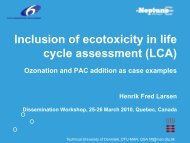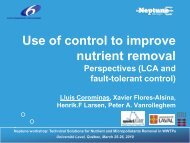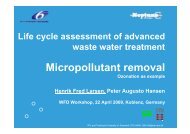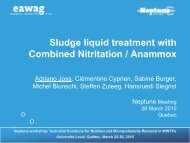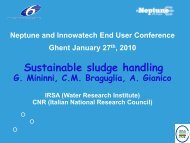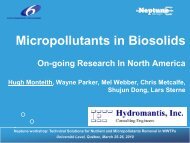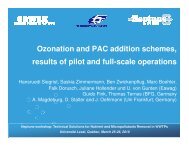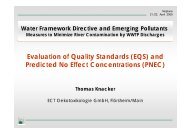D2.1 - EU Project Neptune
D2.1 - EU Project Neptune
D2.1 - EU Project Neptune
You also want an ePaper? Increase the reach of your titles
YUMPU automatically turns print PDFs into web optimized ePapers that Google loves.
NEPTUNE · Contract-No. 036845 Deliverable 2.1<br />
4.2.4.2 Acidogenic fermentation<br />
Fermentation refers to the conversion by acidogens of substrate to alcohols and organic<br />
acids. With regard to the generation of feedstock for biopolymer production, the objective is<br />
to ferment organic material into VFAs. In continuous fermenters, the retention time should<br />
be long enough to support the growth and activity of acidogens, but short enough to washout<br />
slow growing VFA-consuming methanogens. The growth of methanogens can also be<br />
inhibited by the generally acidic pH of the fermenter (5.5-6.5). For fermenters treating<br />
complex waste streams, retention times of between 1 and 4 days are typically employed.<br />
Fermentation of primary sludge has been widely reported, but the feasibility of WAS<br />
fermentation has been limited by its relatively low biodegradability. This research shows that<br />
fermentation of thermally hydrolysed waste activated sludge (HPHT-WAS) leads to high VFA<br />
yields (0.50 gCOD VFA per g of soluble chemical oxygen demand (SCOD).<br />
4.2.4.3 Selection of PHA-storing organisms<br />
Enrichment of PHA-accumulating organisms is conducted by exerting a selective pressure<br />
via aerobic dynamic feeding (ADF) exposing the biomass to periods of substrate availability<br />
(feast) followed by substrate limitation or starvation (famine). During feast, VFAs are stored<br />
as PHAs and during famine the stored PHAs are consumed as a carbon and energy source<br />
by the accumulating bacteria, giving them an advantage over non-accumulating bacteria.<br />
ADF can be conducted continuously in an activated sludge system with a selector<br />
(Bengtsson et al., 2008) or in batch in sequencing batch reactors (SBRs). Exposure to feast<br />
conditions has to be ≤ 20% of the total aerobic exposure or cycle length in SBRs (Figure<br />
4.9). Other important design considerations are the retention times, both hydraulic and<br />
sludge retention times (HRT and SRT), the length of the cycle and organic loading rates<br />
(OLRs).<br />
Figure 4.9 Experimental profiles of total organic carbon (TOC), VFAs and biomass<br />
PHA content during a cycle in an SBR selecting for PHA-storing organisms. PHA<br />
production reaches a maximum immediately after VFA consumption during the feast<br />
phase, which corresponds to less than 14% of the cycle basedon VFA availability.<br />
34



